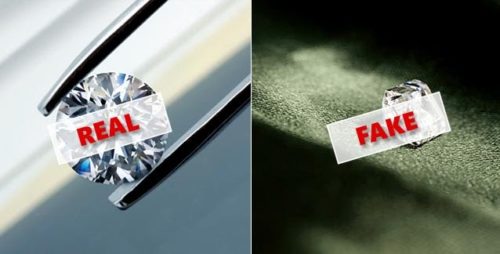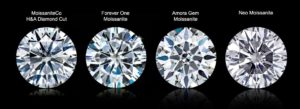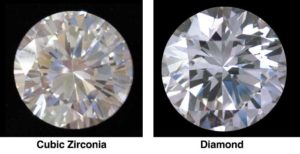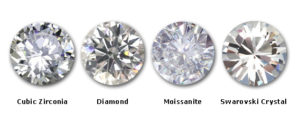
One of the most common questions that gemologists are asked is how to tell the difference between a real diamond and a fake diamond. If you have inherited some jewellery or have bought some from various sources – car boot sales, antique shops, jumble sales etc. – there are a few simple checks you can carry out yourself before bringing the pieces to an expert to evaluate.
Listed below are fourteen checks that can mostly be carried out at home. All you need is a little bit of light, some water or warm breath, and a jeweller’s loupe (a 10 x magnification glass which can be purchased at a jewellery store or online).

1. Look at the diamond and setting through the loupe.
This will help you to see the clarity and colour of a diamond. The majority of diamonds produced by nature will have naturally occurring imperfections (inclusions) in the carbon. In real diamonds these inclusions will have occurred naturally during its growth process. Therefore, when viewing a stone with a loupe you will probably see some inclusions. Look for small flecks of minerals, or very slight color changes. These are both signs that you are dealing with a real, albeit imperfect, diamond.
A fake stone, such as cubic zirconia or moissanite, will look a little too perfect when examined under a loupe and will not contain any inclusions. Cubic zirconia and other man-made materials tend to be produced in a controlled environment as they are created to look totally flawless. They will therefore look quite different under a loupe than a natural diamond.
However, gem-quality diamonds grown in a lab can be chemically, physically and optically identical to real diamonds (and sometimes superior) to naturally occurring ones. They will have no imperfections because they are also produced in carefully controlled environments. In some cases they will, have been grown from a seed or grain, which may leave a very specific type of inclusion in the stone. This ability to surpass the quality of “natural” diamonds has caused considerable concern among those in the mined diamond industry who have lobbied heavily to have lab-grown diamonds distinguished from “natural diamonds”. Lab-grown diamonds are “real” but they are not “natural”.
However, if you are fortunate enough to own a flawless diamond this is different and very valuable. In this case a diamond that appears perfect under the loupe is not necessarily a false diamond. Other factors will have to be examined to determine if the stone is genuine.
Also observe the diamond’s edges. When viewing a diamond through a loupe, a real stone will have sharp or faceted edges, whilst a fake one will tend to have rounded and smooth edges.
In the case of a diamond ring, such as an engagement ring, check the mounting and etchings to see how the diamond is set. If the ring is of poor quality – for example, gold plated or silver – it probably means the diamond is also not real. Real diamonds are almost always mounted and set in gold or platinum.
Check if the ring has any hallmarks or stampings. For example, a “CZ” stamp means the center stone is cubic zirconia. A ring setting that appears to be peeling or that doesn’t have a stamp is also an indication that the centre stone is of inferior quality. Rings that are hallmarked 750 or 950 indicate 18ct gold or platinum, in which case it is more likely that the stone is genuine- although this alone is no proof.
Look at the gemstone through one of the bezel or star facets on the crown. If the stone shows doubling, which means it looks like there are two of each facet lines, then it is probably moissanite. If you see only one of each facet line (singly refractive) and it passed the heat test (see below) then it may be a natural diamond.
Beware that other materials such as cubic zirconia (CZ) are also singly refractive. You can identify a real diamond from a CZ by looking at the girdle (the narrow edge around the circumference of the stone). Real diamonds will have either a frosted, grainy look or tiny facets around the girdle, whereas a CZ will be completely smooth.

2. Rub sandpaper against the stone or scratch it against a mirror. (Note this test not advisable). In theory, this is an easy test since diamonds are one of the world’s hardest materials and won’t be scratched by the rough surface. If it is a diamond it will remain perfect, if it’s a fake it will get scratched. However, there is a measurement which measure mineral hardness. This is called the Mohs scale and was invented in 1812. Glass is rated a 5.5, and diamonds are a 10. So genuine diamonds will scratch a mirror. On the other hand, so will quartz (7), moissanite, and cubic zirconia (8). Cubic zirconia engagement rings are almost as hard to scratch as their diamond counterparts. Most well made synthetic diamonds will seem authentic if you only use the scratch test. Since real diamonds are brittle and may chip we discourage using this method as it could result in damaging a perfectly good diamond. And if a stone does prove to be a fake you might find you have damaged a nice piece of costume jewellery!
3. Try the ‘Fog Test’ (or ‘Breath Test’): Do the fog test. Breath hot air onto your diamond in the same way as you would if you were cleaning your glasses. This test can easily be done with either a mounted diamond or a loose diamond. A fake diamond will fog up for a short period of time whereas a real diamond will not because it will not retain the heat. Real diamonds do not retain heat well. On the other hand, a moissanite engagement ring will get a fog that then fades away, just like your glasses or a mirror. This test works best with a clean stone. If you have a diamond that you know to be real, it is advisable to try this method with both the real stone and the suspect stone and compare the results.
4. Hold it in the light to see how it sparkles. The way that diamonds reflect light is unique; inside the stone the diamond will sparkle gray and white (known as “brilliance”) while outside it will reflect rainbow colors onto other surfaces. This dispersed light is known as “fire”. A fake diamond, however, will have rainbow colors that can be seen inside the diamond. This could be a sign that it is not a diamond.

Moissanite is doubly refractive, which means it is much more sparkly than a diamond, with a lot more fire. In overhead or direct light moissanite will often have a “disco-ball effect” and throw bright rainbow sparks in all directions. In comparison, a cubic zirconia gem will seem much more dull compared to a diamond or moissanite stone and therefore not nearly as sparkly.
5. Look at the stone’s refractivity. The transparency test. Diamonds are very sparkly because of the way they refract and bend light. Glass, quartz, and cubic zirconium may mimic a diamond’s brilliance, but they have much lower refractive indices.
Check Refractivity
The simple dot test: Draw a small dot with a pen on a piece of white paper and place the stone directly over it. Observe the stone from above. If you cannot clearly see the see the dot, directly below, the stone is most likely to be genuine. If your stone is not a diamond, you will see a circular reflection in the stone.
A real diamond should refract light so intensely that you cannot see through it, causing the light to bend and curve with every movement. A fake diamond will not have this effect due to its lack of density.
The most effective way of using this method to test a diamond’s authenticity is the newspaper method or ‘Read-Through’ effect. This involves placing a loose diamond on a newspaper and looking carefully to see whether you are able to read the printed letters through the stone. If the stone is a diamond with a decent cut grade, it should sparkle enough that you cannot see through it to read the words on the page. In the case of cubic zirconia you should be able to see right through. A fake diamond will let the black shine through, and you may even be able to read a word depending on the size of the stone.
Please note that if the cut of the stone is not proportionate, meaning the sides of the diamond are not all equal to each other, the print may still be discernable through a genuine diamond. Hence this test works best with modern cut round brilliant stones, as opposed to irregular vintage old cuts. It is not as easy to use this method when testing a mounted piece of jewellery. However if this is the case, when viewing the diamond from on top make sure you can’t see through it to the mount itself — if you can that’s not good as the light is just shinning through and will again suggest the stone is not real.

6. UV light test. Many diamonds will glow blue under UV or black light. If you have a strong UV or black light on hand you might be able to try this test at home. But I would recommend going to your local jeweller. Jewellers should have high-powered UV lights to test and demonstrate diamond fluorescence in both loose and mounted stones. The presence of a medium to strong blue confirms that it is real. However, it must be noted that not all diamonds are florescent and hence this test cannot be conclusive. Diamonds can also fluoresce in a range of other colours such as yellow and green. To confuse the matter some moissanite stones will also show a presence of fluorescence. Under UV light these can demonstrate “very slight green, yellow, or gray” fluorescence.
Finally it is also possible for fake diamonds to be “doped” or treated so that they glow under UV light when they otherwise would not.
Get an x-ray examination. Diamonds have a radiolucent molecular structure, which means that they do not appear in x-ray images. Glass, cubic zirconium and crystals all have slightly radiopaque qualities that make them show up clearly on an x-ray. In order to carry out this test you will either need to submit it to a professional diamond testing laboratory or make a deal with your local GP surgery, dental clinic or x-ray imaging centre!
7. Heat it up. A word of caution for this test – only perform this test if you are sure you do not mind destroying a fake stone or piece of costume jewellery! Diamonds are an incredibly strong material and therefore this test will not break them. However, many fake diamonds, including those made of glass, cubic zirconia or quartz, will break or shatter during this test. Note also: A traditional heat probe test will not be able to tell the difference between moissanite and a real diamond as they both disperse heat quickly (see below).
In order to carry out this test, first heat up the loose stone over a lighter or candle flame for about 30 seconds. Then, immediately drop the stone into a glass of cold water. A real diamond will not react at all, despite these extreme temperature changes. A fake diamond will most likely crack or shatter from the inside.
One should be wary of carrying out this test on a real diamond that has undergone specific treatments, such as fracture filling or coating. The intense heat may reverse the treatment and end up damaging the stone. Overall, it is best to avoid using the heat test as one can never be sure whether a diamond has been treated or not and this requires specialist equipment.

8. Heat probe test. Instead of measuring whether the gem breaks under the pressure of rapid contraction, the heat probe test measures how long the diamond retains its temperature. The Heat probe tests take about 30 seconds and will measure the thermal probabilities of a stone. With a diamond, because of the tight, evenly-packed crystalline structure, heat is dispersed quickly and therefore it does not heat up easily unlike other stones. The advantage of this test is that it will not damage artificial stones in the way that the heat test outlined above will.

9. The Water test- drop it in a cup of water. Diamonds are so dense, they should sink to the bottom when dropped in a glass of water. Many diamond fakes – glass and quartz included – will float to the middle or top, or not sink as quickly, because they are less dense. However, this test is not foolproof. Heavy cubic zirconia and moissanite can have the ability to dupe this test.
10. Test the conductivity. Diamonds conduct electricity – a little-known fact. Testing a stone for conductivity is especially helpful if you are not sure whether your stone is a diamond or moissanite. Moissanite (if it is made well) can be extremely difficult to tell apart from a genuine diamond. One relatively simple way to tell the difference is that moissanite will not conduct electricity with as much strength as a diamond. With the rise of moissanite in today’s diamond market, the majority of jewellers will have an electricity testing tool on hand to determine the real from the fake.
11. Test with a Thermal Conductivity Probe (also known as a diamond tester): Diamonds are efficient heat conductors. The thermal test separates most fake diamonds from real diamonds by detecting the rate at which the stone disperses heat. This test works on most gemstones, with the exception of moissanite. A moissanite stone may register as a real diamond with the thermal test.
To tell the difference without special equipment, between a diamond and moissanite, hold the stone close to your eye. Shine a penlight through the stone. If you see rainbow colors, that is a sign of double refraction. This is a property of moissanite, but not of diamond.

12. Get a microscopic examination. Place the diamond under a microscope with the top facet face down. Gently rock the diamond back and forth with tweezers. If you see a slight orange flash along the facets, the diamond may actually be cubic zirconia or it may indicate that cubic zirconia was used to fill imperfections within the diamond. To be sure, further examination will be required. For the best view of the diamond use a 1200x power microscope.
13. Subject the diamond to high sensitivity weighing. Diamonds can be distinguished by very fine differences in weight, since cubic zirconia weighs approximately 55% more than diamonds for the same shape and size. A very sensitive scale, capable of measuring down to the carat or grain level is necessary to do this comparison – ideally a diamond scale.
The easiest way to accurately perform this test is by having a real diamond of roughly the same size and shape to compare. Failing that, measuring the dimensions of the stone and comparing it to weight ratios of a genuine diamond should be a good indication of whether a stone is genuine or not.
14. Visit a trusted Professional. Visiting a trusted professional should help put your mind at ease. Many jewellers and diamond professionals, including independent gemologists, will verbally appraise your stone free of charge and experts will often be able to tell immediately if your diamond is authentic or not. If your stone came with a certificate, they should be happy to look at it and tell you whether it matches up. Should you require in depth analysis and written confirmation of authenticity do expect to pay for the service.

